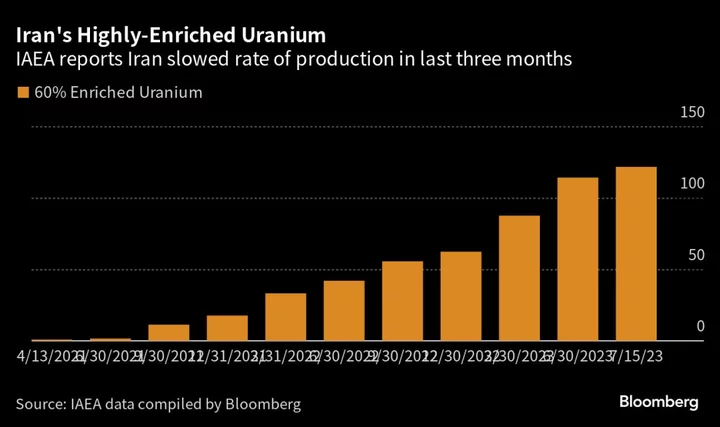Iran slowed its production of near weapons-grade uranium in recent months, the latest in a series of signals that the Islamic Republic may be ready to re-enter talks about the scope of its nuclear program.
Inspectors from the UN atomic watchdog told diplomats Monday that Iran’s stockpile of highly-enriched uranium grew just 7% in the last three months compared with a 30% increase in the previous quarter. That’s the most dramatic slowdown since the country began purifying the heavy metal to higher grades in 2021.
Iran’s engineers also took the unusual step of diluting more than 5% of its highly-enriched inventory, according to the restricted 12-page report prepared by International Atomic Energy Agency inspectors and seen by Bloomberg. And it paused plans to reconfigure centrifuges enriching to high purity levels.
The shift follows months of secret diplomacy between Tehran and Washington that have led to an understanding to free American prisoners held by Iran and release billions of dollars in Iranian funds frozen by the US and stranded overseas.
While US officials have been careful to distinguish that progress from formal nuclear talks, which remain stalled, Iranian Foreign Minister Hossein Amir-Abdollahian has indicated that his country may be willing to discuss potential limitations on its nuclear work with world powers.
Iran has modulated uranium output to signal diplomatic readiness in the past and Supreme Leader Ayatollah Khamenei said last week the Islamic Republic should be ready to communicate with all other governments “with one limited exception,” an apparent reference to Israel, whose right to statehood Tehran doesn’t recognize.
Iran began enriching to 60% in retaliation for a 2021 attack on its largest nuclear fuel plant in Natanz, which it blamed on Israel. While that purity is still below the 90% grade typically used for weapons, it’s much higher than the 300 kilograms at 3.67% purity cap set by the now-defunct nuclear accord that Iran agreed with world powers in 2015.
US President Donald Trump later abandoned the pact, reintroducing sanctions and triggering a surge in Iranian nuclear activity. The Biden administration’s efforts to revive the deal stalled after months of talks.
US officials have privately acknowledged they’ve already begun to relax enforcement of sanctions on oil sales, allowing Tehran to restore production to the highest level since the restrictions kicked in five years ago. With the world’s No. 4 oil reserves, Iran has been shipping the most crude to China in a decade and government officials say they’re confident output will only grow.
For Global Oil Markets, a US-Iran Deal Is Already Happening
Monitoring Equipment
Iran’s stockpile of uranium enriched to 60% levels of purity rose to 121.6 kilograms (268.1 pounds) compared with 114.1 kilograms in June, the IAEA inspectors concluded. Inventories of 20%-enriched fuel grew to 535.8 from 470.9 kilograms.
Iran has also allowed new, high-precision monitoring equipment installed by the IAEA in May to continue operating, the report noted.
After the IAEA’s board weighs in on the inspections report, informal contacts may continue on the sidelines of the agency’s general conference convening Sept. 25 in the Austrian capital.
Trust Issues
Even with a reduction in enrichment, however, concerns over past activities persist.
A second report also issued on Monday in the Austrian capital underscored that significant hurdles remain before the country wins back IAEA trust.
“There has been no progress in resolving outstanding safeguards issues,” IAEA Director General Rafael Mariano Grossi wrote. His inspectors are still trying to clarify the source of uranium particles detected at undeclared sites.
Iran still needs to respond to investigators’ questions for the watchdog to “be in a position to provide assurance that Iran’s nuclear program is exclusively peaceful.”
(Updates with details throughout)

